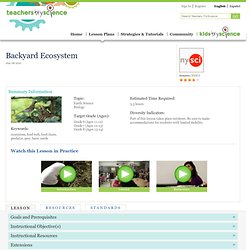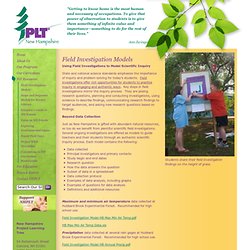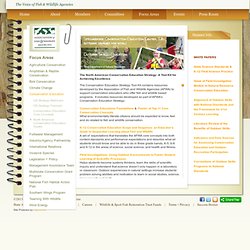Environmental Science
> Content Resources
Science Education Council of Ohio (SECO) Conference : ORC's Science WINDOW. 1ef905db-e597-4f82-9555-6e58a789e8b3. Marine debris is everyone's problem.
'Nature Is a Powerful Teacher': The Educational Value of Going Outside. Four years ago, the nurse at Boston's Young Achievers School was overwhelmed.

Previously a middle school, Young Achievers had recently become a K-8 school and there was no appropriate space for recess. Instead, according to a teacher at the school, students spent recess in “a disorganized, cracked, muddy parking lot,” where they ran between and bounced balls off of cars. That changed when a group called the Boston Schoolyard Initiative began a community planning process to build a new playground and outdoor classroom at the school.
Today, students spend recess digging in a sand box, crafting tunnels through a bramble, and playing in a stream—and asphalt injuries no longer fill the nurse’s office. Young Achievers is just one of the 88 schools the schoolyard initiative has renovated since it began bringing green space to urban schools in 1995.
Time to Write? Go Outside. Environmental media and education, in honor of Philippe Cousteau Sr.
Guest speakers. Science resource pairs students with real data analysis. Science education gains another link to real-world applications with new institute Students track marine animals’ progress using real science data.

ohiodnr.com/portals/9/pdf/WOWebKids2011.pdf. EcoMUVE. EcoMOBILE. MyEnvironment Query. Great Lakes Environmental Monitoring with Passive Samplers on SciStarter. Photo: Lohmann Lab Required Gear: Supplies will be provided to set up and secure your sampler.

We are also happy to provide additional teaching materials concerning the significance of the project and how the samplers are analyzed.
Backyard Ecosystem. To start, you may want to watch this video entitled What is STEM Education?

What is STEM Education Be sure to visit the Project Noah site before starting the lesson at Before students go out into the field, you should create a mission on the Project Noah site. This should include a brief description of what you'd like students to do,as well as more specific instructions and a timeline for completion of the project. In order to add a mission, you must contact the site, so be sure to allow enough time prior to the start of the activity. You may choose to assign the field visits as homework or do them during class time.
Even urban areas have ecosystems.
NH Field Investigation Models. Using Field Investigations to Model Scientific Inquiry State and national science standards emphasize the importance of inquiry and problem-solving for today’s students.

Field investigations offer rich opportunities for students to practice inquiry in engaging and authentic ways. Key steps in field investigations mirror the inquiry process. They are posing research questions, planning and conducting investigations, using evidence to describe findings, communicating research findings to target audiences, and asking new research questions based on findings. Beyond Data Collection Just as New Hampshire is gifted with abundant natural resources, so too do we benefit from plentiful scientific field investigations. Maximum and minimum air temperature data collected at Hubbard Brook Experimental Forest. Field Investigation Model HB Max Min Air Temp.pdf HB Max Min Air Temp Data.xls Precipitation data collected at several rain gages at Hubbard Brook Experimental Forest.
Useful Links. Biotechnology. Biodiversity. The Voice of Fish & Wildlife Agencies: North American Conservation Education Toolkit. The Voice of Fish & Wildlife Agencies Focus Areas The North American Conservation Education Strategy: A Tool Kit for Achieving Excellence The Conservation Education Strategy Tool Kit contains resources developed by the Association of Fish and Wildlife Agencies (AFWA) to support conservation educators who offer fish and wildlife based programs.

ConEd-Sustainable-Tomorrow-Systems-Thinking-Guidebook.pdf. ConEd-Field-Investigations-Guide.pdf. Exploring Oceans. COSEE Ocean Climate Interactive. Classroom Earth. Education. FREE Printables from MakeBeliefsComix.com!
Six Outdoor Education Resources for Parents. What's the best cure for the summertime blues?

How about outdoor education? The backyard or local park are great places to soak up the sun and dive into a citizen science project or a quick environmental ed lesson. So if you know someone suffering from summer boredom, here are some hands-on, DIY outdoor education ideas that are great for kids. 10 Awesome Outdoor Summer Learning Ideas: Part of MindShift’s summer learning series, this blog by Jennie Rose is chock full of fun! Rose covers citizen science projects -- like habitat learning tool YardMap -- DIY gardening and recycling projects, and plenty of other super fun activities.
Microbeads threatening waterways. A common additive in soaps and other personal cleaning products has become a pollution threat to Ohio’s waterways.

Companies that make and sell soaps, facial scrubs and toothpastes call them microbeads — tiny plastic balls that create friction to help scour teeth and exfoliate dead skin cells. “Have you ever washed your hands with hand soap that feels a little bit gritty?” Said Jeffrey Reutter, the director of Ohio State University’s Stone Laboratory on Lake Erie. “Those are microplastics.” Researchers have found the microbeads and other bits of plastic floating on the surface of the world’s oceans. The concern is that fish and other aquatic wildlife mistake the beads for food, putting them at risk from harmful chemicals in the plastics and other pollutants they absorb in the water. What they do know is that the beads wash down bathroom drains and travel to sewage-treatment plants where they pass through filters and into streams.
In August 2012, a Santa Monica, Calif. shunt@dispatch.com. Ohwildeducation.








